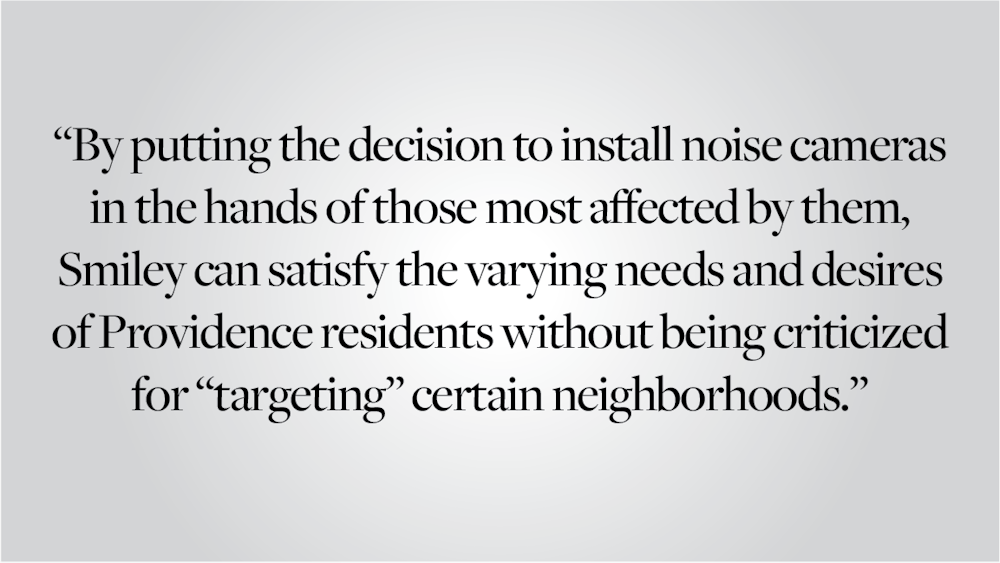I would like to think that the drivers who roar down Thayer Street in their souped-up sports cars and motorized tricycles aren’t trying to make others miserable. Maybe they’re overcompensating — for a lack of length and/or width. Or, perhaps these drivers never grew out of their childhood obsessions with “Cars 2" and seek to channel Mater wherever they go. Speculations aside, intentionally loud automobiles scourge the streets of Providence, and Mayor Smiley’s proposal to install noise cameras is a pragmatic solution — with a few necessary modifications.
The purpose of a noise camera is to detect when a vehicle commits a sound violation. Once detected, footage of the offending vehicle is then reviewed by a human operator who determines whether or not to levy a fine. Starting in early 2022, major cities like New York have effectively implemented noise cameras. New York has acquired nine more cameras since the program’s implementation and passed legislation to install at least five in each of its boroughs by next year. More than 90% of contested noise violations in New York have been upheld, proof that current noise camera technologies provide sufficient data to issue fines. Noise cameras work, and we need to bring them to Providence.
Providence’s noise pollution is not just obnoxious — it’s also a threat to our health. Exposure to chronic noise leads to an extended stress response and attendant pathologies: headaches, atherosclerosis, inflammation, and cardiovascular disease. Research by the World Health Organization claims that ambient traffic noise above 53 dB is associated with adverse health effects. For context, the average noise level of College Hill — the second quietest part of Providence — is 56 dB. In short, the car barreling down Thayer blasting bass-boosted Cardi B may be contributing to your demise. It’s in the best interest of all Providence residents to support solutions to this issue.
There are some who argue that noise cameras would disproportionately impact minorities and impoverished communities. This argument is hardly convincing. Low-income, predominantly minority neighborhoods are louder, so installing noise cameras would reduce the inequitable distribution of noise pollution in Providence and in turn benefit minorities with ears. As for the people who would be penalized by the noise cameras, there’s no systemic bias compelling drivers to install booming sound systems or remove the mufflers off of their vehicles. If people don’t want to be ticketed, then they ought to be well adjusted adults and not intentionally modify their cars to terrorize those around them.
At the same time, Smiley’s current plan to evenly distribute noise cameras throughout Providence is needlessly paternalistic. Instead of evenly distributing the noise cameras throughout the city, Smiley should consult with community leaders to assess the preferences of their residents. By putting the decision to install noise cameras in the hands of those most affected by noise pollution, Smiley can satisfy the varying needs and desires of Providence residents without being criticized for “targeting” certain neighborhoods.
The question of whether the noise cameras would impinge upon privacy is more open-ended, with groups such as the ACLU raising concerns over “surveillance.” In order to prevent vandalism and provide an overhead view of traffic, the noise cameras will have to be mounted high enough off the ground that ordinary conversations won’t be intelligible. Even so, Smiley does have the responsibility to bring in independent experts to assess the potential for data misuse before selecting a specific camera provider.
Cost is another potential sticking point. The exact amount of money that Smiley intends to spend on the noise camera initiative is unknown since the exact camera model has not been identified yet. One can reasonably extrapolate from the New York noise camera program that the cost for Providence would come out to be roughly $35,000 per camera. Not an insignificant amount, but more palatable in comparison to potential alternatives, such as expanding the police force purely to counteract noise.
In an ideal world, there would be no need to fine drivers into being civilized. But we live in a city plagued by vehicular noise, and we all bear the cost. Now, Smiley is proposing a practical solution to tame the noise in our streets. Let’s hear him out.
Victor Chang ’27 can be reached at victor_a_chang@brown.edu. Please send responses to this opinion to letters@browndailyherald.com and other op-eds to opinions@browndailyherald.com.





